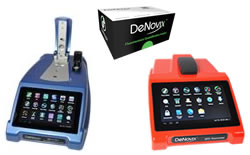Recent News & Events
Absorbance or Fluorescence? Which Method Should You Use When Measuring DNA and Protein Samples with Low Concentrations?
05
 Accurately determining the concentrations of proteins and DNA, as well as their purity, is vital for many areas of molecular biology research. In order to get valid and consistent results that are unaffected by impurities or irregularities it is vital to know whether you will be better off using a flourometer or an absorbance spectrophotometer when measuring your low concentration samples.
Accurately determining the concentrations of proteins and DNA, as well as their purity, is vital for many areas of molecular biology research. In order to get valid and consistent results that are unaffected by impurities or irregularities it is vital to know whether you will be better off using a flourometer or an absorbance spectrophotometer when measuring your low concentration samples.
To get accurate measurements when you are working with samples that have a low concentration of protein or DNA molecules you’ll need to fully understand the specific fluorescence and absorbance techniques used to measure low quantities of DNA and proteins in order to determine which method is best suited to meet your needs.
Absorbance
Absorbance is measured by spectrophotometers and both protein and DNA concentrations can be measured by them. A UV-Vis spectrometer is the most common type found in standard laboratories. Absorbance methods are not as sensitive as fluorescence methods but absorbance spectrophotometers are more common in laboratories and their setup and analysis process is much simpler than measuring by fluorescence. Absorbance spectrophotometers require minimal maintenance, are non-invasive and can reveal impurities in your samples.
However, despite these advantages and their common availability, there are potential problems you need to be aware of when measuring DNA and proteins. Both DNA and RNA absorb UV-light at 260nm so if the absorbance is set to 260nm to measure DNA, the DNA quantity can be erroneously inflated because the DNA is not distinguished from the RNA. Even proteins are not always distinguishable from DNA and RNA molecules. Proteins absorb UV-light at 280nm so they can also contribute to the DNA quantity and overinflate its true value. Absorbance is best used when you have either a protein or DNA sample (not a mixture), but the values still need to be carefully considered since their selectivity is not the greatest.
Absorbance can also be affected by stray light, pH changes, temperature, impurities and solvents. All of which can lead to inaccurate readings.
Fluorescence
Fluorescence is measured with flourometers which are available as standalone instruments or integrated with spectrophotometers which allows for both absorbance and fluorescence methods. Microvolume Spectrophotometers are also available with an integrated flourometer and for anyone that’s planning on purchasing a Spectrophotometer or a flourometer, I highly recommend that you look into them. You can read about Microvolume Spectrophotometer technology.
The sensitivity of flourometers is up to 1000 times greater than that of absorbance, making it better suited for analyzing lower concentrations of DNA and proteins. Flourometers provide a wide concentration range but they only work with molecules that fluoresce. Unlike absorbance, fluorescence methods can also bind to double stranded DNA so distinguishing between DNA and RNA is not an issue.
The setup requires a fluorescent DNA binding dye, a fluorometer to detect the dyes, and the appropriate DNA standards. Dye selection can also have an effect on the size quantification and detection limits. So choosing an appropriate dye is also a key consideration when implementing the fluorescence method. The standard considerations of quenching and photo-bleaching of fluorescent compounds can also effect the signals produced.
Other factors to consider when choosing a flourometer are the cost of the components to perform the measurement and that bubbles, impurities and pH changes within the sample can lead to inaccurate measurements.
When calculating your concentration from either method, dilution factors of your samples need to be taken into account. Each method requires some form of dilution before for the sample can be analyzed so the concentrations must be scaled back up to calculate for the original sample.
